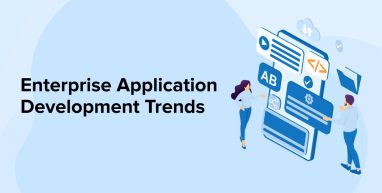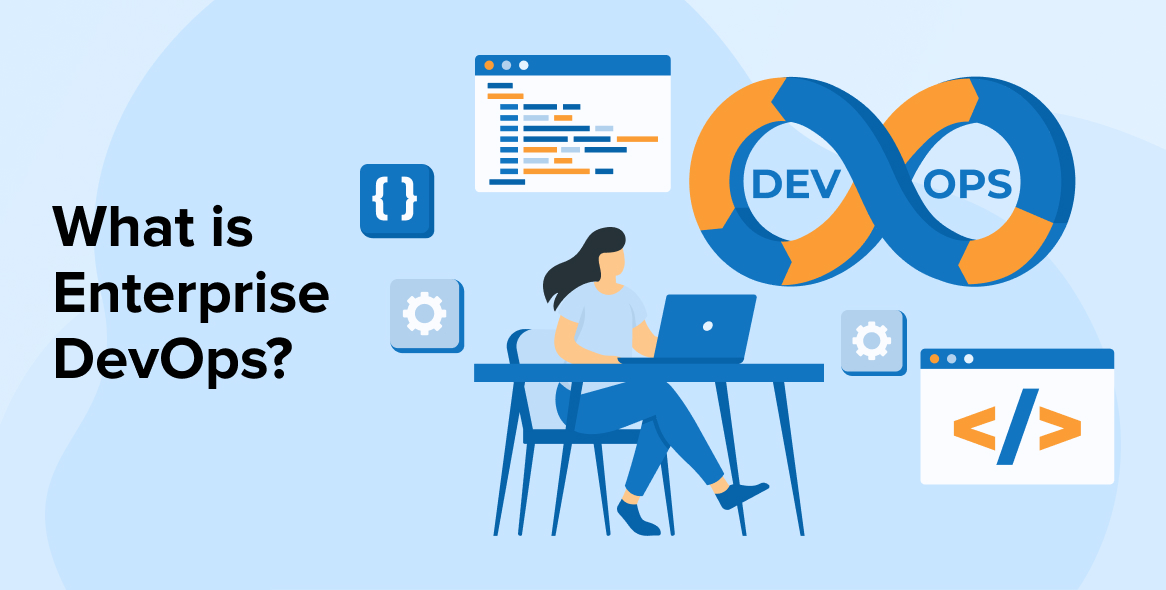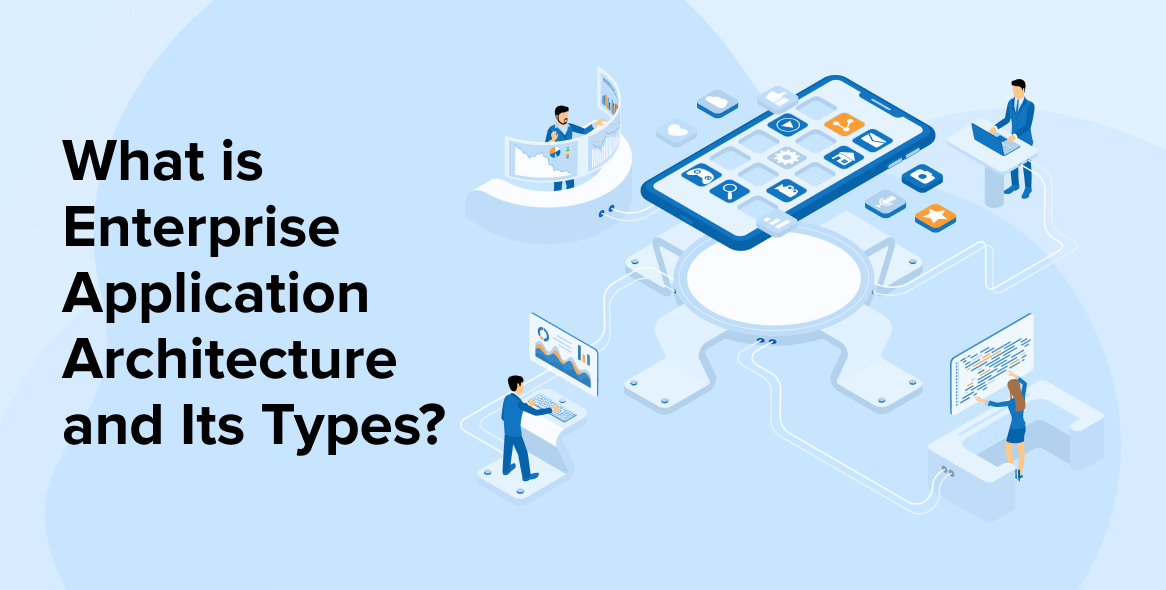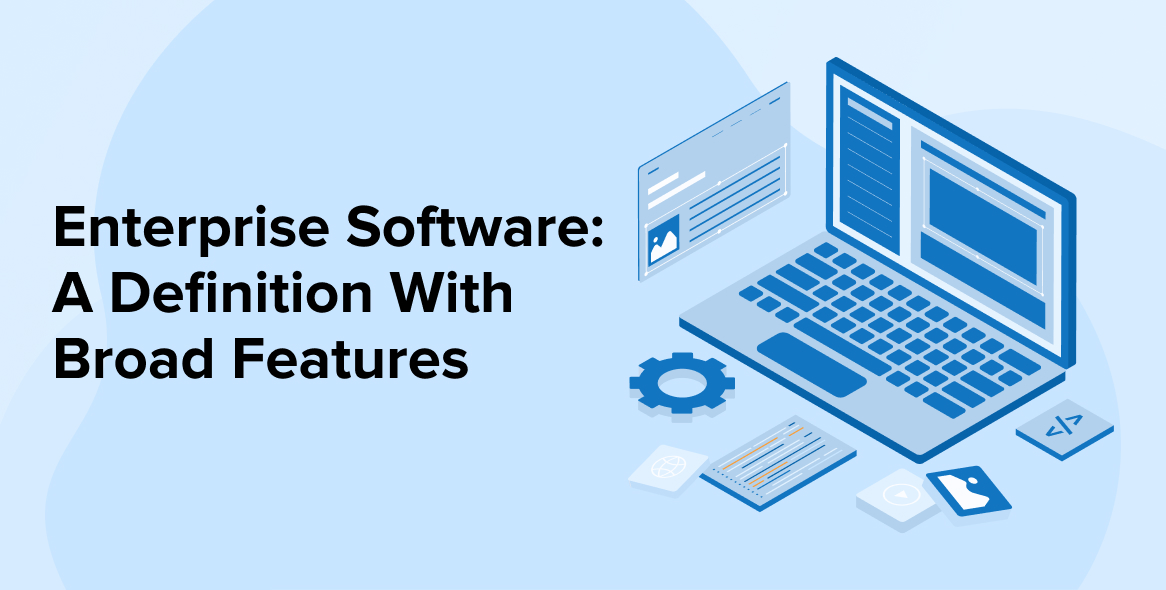
TatvaSoft – is a leading enterprise application development company that empowers your business by utilizing these latest and emerging technologies. Since enterprise software development has gained immense popularity recently, undoubtedly, companies want to outperform their competitors and depend heavily on enterprise software solutions.
The use of enterprise software solutions allows businesses for more standardization, better data processing, stronger security measures, and the automation of the deployment procedure. In this article, you will be able to gain knowledge on how you can improve your enterprise operations by looking at the trends we discuss.
1. What is Enterprise Application Development?
The term “Enterprise Application Development” describes the steps used to build bespoke enterprise software programs for large enterprises or companies. Among the many corporate processes that these apps are designed to handle are supply chain management (SCM), enterprise resource planning (ERP), and customer relationship management (CRM). When it comes to boosting efficiency, improving decision-making, and promoting teamwork in today’s competitive corporate landscape, enterprise apps are essential.
In order to keep up with the competition, manage operations, and simplify procedures, businesses require robust and extensible software solutions. The significance of developing enterprise applications cannot be emphasized enough. Cloud computing, artificial intelligence (AI), and mobile accessibility are just a few of the new trends that are changing the game for workplace application development as a result of technological breakthroughs.
2. Enterprise Application Trends To Follow
Enterprise software is undergoing a sea change as a result of rapid technological development; as a result, company owners would do well to keep up with the newest trends in the industry. Statista predicts that the business software industry will accelerate from its 2024 growth rate of 6.55% to a whopping $376.40 billion by 2028. Business owners should stay updated on the latest trends with a focus on increased scalability, flexibility, and cost-efficiency.
In addition to adopting new technology trends, businesses must maintain a constant pace if they want to remain at the top of their industry. Looking at these trends in enterprise software development will help you keep updated.
2.1 Artificial Intelligence-Driven Solution for Enterprise
IDC’s market analysts have described AI as “inescapable,”. predicting that by 2025, at least 90% of new business applications will embed artificial intelligence.
Every enterprise is inclined toward Artificial intelligence and its development services to enhance application efficiency. This technology trend never goes out of style. Modern AI applications are optimizing operations and increasing conversions for businesses. AI solutions are agile and can contribute to making the enterprise more powerful with improved business offerings.
Artificial intelligence is one of the major trends in enterprise software development. It is driving market growth in a variety of sectors, including broadcasting and television, banking, and consumer products. AI is assisting companies to stay relevant and seize new engagement and growth opportunities.
When you decide on enterprise application development and integrate it with the latest technologies like AI, you can create unique applications for your business. This includes AI-enabled eCommerce applications, gaming apps, chatbots for enterprise applications, HR management tools, and more.
2.2 Microservices for Enterprise Software Solutions
With microservices, you can develop enterprise-grade apps by dividing an entire program or application into smaller components that each carry out a particular task. Enterprise software development businesses can seamlessly weave together independent, distinct components to produce software that suits specific objectives. This approach breaks down monolithic applications.
Enterprise software developers can save time and avoid repeating efforts by reusing containers for storing microservices. Alternatively, they can incorporate a pre-existing microservice that is effective at doing the task.
If you want to boost your company’s performance and revenue, microservices is the best way to go. You can also improve collaboration among teammates for your software development project by employing this practice. Top companies like Netflix and Amazon utilize Microservices, therefore it is very popular among software developers.
2.3 Big Data
The world is changing, and data is the key element of change. Data has been observing changes, capturing them, and predicting the trends. Businesses now rely on Big Data and its services for faster, more accurate, and reliable business interactions. Statista predicts that the global big data and business analytics market, valued at 168.8 billion U.S. dollars in 2018, is forecast to grow to 274.3 billion U.S. dollars by 2022. This represents a five-year compound annual growth rate (CAGR) of 13.2 percent.
We already know the potency of Bigdata and its impact on transforming the lives of customers by providing a personalized business experience. Furthermore, enterprise applications will improve over time, enabling quicker assistance and lowering expenses while delivering outstanding customer support.
Data is essential for the future of every business from any domain like retail, eCommerce, manufacturing, banking, telecom, or any other major industry. No enterprise is excused from the ocean of data, and this data contributes to business profitability. Big Data and machine learning have significantly improved voice recognition, leading to the development of various self-help programs that can predict actual customer needs.
Examples of the type of integrated enterprise applications such as CRM, HRM, and other data management or cloud storage platforms.
2.4 Trends in IoT Applications
The Internet of Things (IoT) has been evolving for some time. Internet-of-Things(IoT) systems are successfully re-engineering companies and changing the optimum ways of operating them, since the adoption of new measurements for a post-ISA world. Nearly every current industry is impacted by these innovations, including healthcare, banking, smart cities, engineering, transportation & logistics, retailing, and other functions.
The demand for connected electronic product manufacturing is rising. Individuals are finding it beneficial due to the capabilities of IoT for their personal use like smart homes. The trends in IoT for software development have promised that business investors are persuaded that their resources should be invested in sensor-based technology. In almost every current market, IoT has the potential to enhance the consumer experience.
IoT is one of the major enterprise software development trends, and it has improved the way how businesses operate. It is a smarter and more insightful operation for companies to adopt this technology in their enterprise software development. Your business can make quicker decisions, monitor, and get assistance in real-time with precise data in real-time.
Examples of integrated enterprise applications are connected smart homes, IoT Sensors, IoT Data Analytics, IoT-connected factors, Smart Supply Chain Management, and Smart Barcode Readers.
2.5 Transition From Low Code Enterprise To No-Code Software Development
No-code coding, as the term suggests, involves users to design programs without writing any code. With low-code platforms drag-and-drop editors are improving, allowing newcomers to create software or mobile applications without writing a single line of code. While some people consider no-code (NC) to be a more sophisticated version of low-code (LC), others claim that there is little to no difference between the two, with no-code being promoted as a sophisticated version.
Low-code development has a lot of potential, it allows developers as well as non-developers to build flexible apps in less time. Many businesses have understood that low code is currently the most transformative force in technology growth, empowering millions of non-technical leaders and users. In the coming years,low-code solutions will continue to broaden their integration ecosystem, defining standard functionalities and turning them into ready-to-use code blocks.
Undoubtedly, the market of no-code is predicted to grow by 28.1 compound annual growth rate (CAGR) to reach $45.5 billion by 2025- Source
Examples of integrated enterprise applications are Customer Relationship Management (CRM) systems, project management tools, and programs integrated with web and mobile apps.
2.6 Data Security By Blockchain Technology
Blockchain technology is a significant trend in enterprise software development. It reduces transaction costs, speeds up transactions, and creates trust between parties. This distributed ledger technology could also support smart contracts in addition to payments. Computer protocols are used to execute or validate contracts. This would contribute to the use of Blockchain in the enterprise for defense, trade finance, and other financial processes.
Blockchain technology is a key solution for enhancing data security, specifically for businesses having large amounts of unprotected data. This question gave rise to multiple business aspects that need to be concealed and kept under confidentiality. Blockchain is decentralized, it has given rise to the security of data through its distributed ledger function. This leads to Blockchain being used in almost all activities from financial transactions, to contracts, or other essential business operations. If you think Blockchain has limited usage, consider this: worldwide spending on Blockchain solutions will reach $11.7 billion by 2022. The global Blockchain technology market is estimated to accumulate $20 billion in revenue by 2024. –Source
This clearly means that there is an unprecedented increase in the usage of Blockchain. Here are the examples, Smart contracts in the legal business, data security in software using encryption, and distributed ledgers.
2.7 Virtual and Augmented Reality
Augmented and virtual reality speeds up and simplifies enterprise software development activities. It enables workers to collaborate remotely, reducing the possibility of errors. Virtual reality allows companies to benefit from complete digital simulation, it combines real-time data visualization with intuitive data comprehension. Customers can utilize augmented reality to mimic any situation in order to prepare workers in a real-world setting to help them gain valuable expertise.
Examples of the different types of integrated enterprise applications are industrial field apps, retail platforms that create a virtual shopping space on how the merchandise will look to customers, gaming, and other web and mobile apps.
2.8 Cloud-Based Enterprise Software Apps
One of the most essential technologies in today’s business landscape is Cloud-based technologies. Currently, traditional on-premise applications have hit their limit. Cloud infrastructure has emerged as a viable alternative implementation platform for enterprise software development services. Due to the need for valuable insights provided on time to boost business results, cloud-based enterprise computing has become very common. Integrating cloud infrastructure and enterprise systems provides major improvements to the challenges of enterprise software development.
The global end-user spending on public cloud services is expected to grow 18.4% this year 2021- Source.
The exponential growth in cloud infrastructure is evidence that businesses continuously rely on the cloud. The agility and scalability that cloud computing offers to businesses can help seamlessly manage enterprise software even from a distance. Global spending on the cloud is projected to increase, indicating a strong tendency towards investment that can be more successful outcomes.
Examples of these cloud-based enterprise software apps are IaaS, PaaS, and Cloud as storage for databases among Other essential aspects that make the cloud compatible with web and mobile applications.
2.9 Last Trend- Smart Enterprise Application
Smart and improved enterprise apps enable businesses to have a much smoother and more customized service for their consumers. Companies now depend on these tools to provide insight into their businesses and to assist their staff with data collection and analysis. Smart business apps enable workers to quickly view sensitive consumer data, such as past invoices and purchases, allowing them to offer superior support through customer support teams.
Enterprise applications are one smart way of doing multi-functional business. In fact, you can use all other technology innovations together in this app and make it efficient to bring improvements within the business. It is an easy way to increase productivity and reduce costs.
Examples of smart enterprise applications such as storage cloud, servers, and applications built using IaaS, PaaS, or SaaS.
1.10 DevOps
While the idea of DevOps has been around for a while, it has only just begun to gain traction in the field of application development. In recent years, containerization has emerged as a prominent approach within the DevOps techniques.
Just as Agile enables collaboration between business and development teams to enhance the delivery process, this trend urges security practitioners to modify and update their long-standing security processes and procedures.
Enterprise architects, developers, security experts, and operations may all work together as a cross-functional team to speed up and improve application delivery to production. By integrating security into the software delivery process through policy-based automation and by making the enterprise application development process smooth and repeatable through continuous integration and delivery (CI/CD), businesses can overcome the challenges of enterprise application development, improve their time to market, and secure a competitive advantage.
1.11 Remote Working
1. Hyperautomation
One of the most notable developments recently is the widespread adoption of process automation across all levels of a company. This was due to the fact that automation has the potential to greatly improve efficiency and save costs in many different domains, including software development.
A new trend toward hyperautomation is emerging. To automate as many business and IT processes as feasible, it unifies teams and processes by combining tools and technologies like RPA, AI, ML, process mining, analytics, and other cutting-edge solutions.
This represents a natural progression in the evolution of the digital enterprise paradigm. With the use of automation and machine learning, human analysts will be able to extract more useful data from inputs, and businesses will enjoy increased efficiency, speed, and production.
2. Digital Twins
Data is the heart of every company, and a competitive advantage can be yours with the right strategy for collecting and utilizing it. As a relatively new tool for predictive analytics and Big Data, digital twins are gaining popularity.
A digital twin is an exact digital copy of an actual product, service, or process. By simulating a process and then collecting data regarding it, digital twin technology can be employed to forecast the process’s performance. A digital twin, as it refers to the development of business applications, is a software application that uses real-world data to generate simulations that calculate the performance of a product or process. To increase performance and promote innovation, these virtual models are powered by AI, ML, big data, and the Internet of Things (IoT).
3. App Security
Your company’s reputation will take a hit from any data security incident, and it could be too much to overcome. The level of confidence that clients have in a company is directly proportional to its reputation, which is why security measures for app development continue to be trendy.
Companies nowadays include many layers of extra protection into their apps to prevent breaches and data compromise. These layers include vulnerability checks, frequent software upgrades to increase security, and multi-factor authentication.
3. Conclusion
Finally, we have reached the end of the blog, where we have seen almost all technologies that are ready to disrupt the world of business. There is no doubt that in 2021 and beyond, businesses will be seeing continuously evolving enterprise software development trends and experiencing groundbreaking developments. To remain ahead of the rivals, you must maintain high spirits and in advance develop a strategy for it. Create a plan to reap the gains of these cutting-edge technologies.






Trends Mentioned by you in this article will surely have an impact in the upcoming future. Evolution of new technologies like virtual reality , cloud computing will change the landscape of software development. Cloud computing is making a major impact in software development as new technology will come and they will change the entire scenario of software development.As we have seen, 2020 has been a significant year for the software development industry with lots of breakthroughs.
Most ideal choice depends upon our requirements, but making the wrong selection can be both costly and time consuming.When making the selection, Our prime concern should be the efficiency with which software serves our company and other partners in the best possible way.Custom software offers some advantages which can be beneficial for longer terms. Custom software can serve startups better than shelf software.